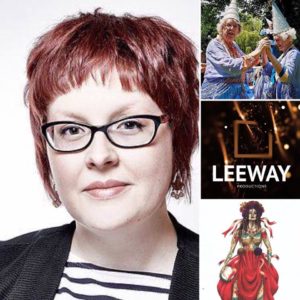
Hi Becky great to meet you, can you give our readers some background information on yourself please?
Currently, my work involves three core roles. I’m a freelance Set and Costume Designer for Theatre and Performance, I am an Artist who mainly produces artwork via commission, and I am a part-time Senior Lecturer on the BA(Hons) Creative and Therapeutic Arts course. I am also an Associate Artist of Taking Flight Theatre Company (who produce accessible and inclusive performance), and a resident designer for new musical theatre company, Leeway Productions.
http://www.beckydavies-theatredesigner-artist.com/about
So what got you interested in the arts ?
It may sound a cliché (but it is the absolute truth!). I was obsessed with drawing and painting from as soon as I could hold a pencil. This was my absolute first love and my way of telling stories and inventing worlds. I have always had a vivid imagination and I used to routinely dress up in elaborate costumes and build cities out of cardboard, towels, sheets, rope, chairs and pegs, whatever was available.
I was very lucky as I was encouraged by my parents and teachers to pursue my passion and follow a path towards a creative career. I had a romantic idea that I would end up as a Parisian Bohemian in an attic studio in Montmartre! To earn money while at school and then university, I facilitated art workshops in holiday playschemes for a Welsh language charity from the age of 15.
By the time I had reached Atlantic College, I was making wearable sculpture in my art lessons and I thought I was going to go into fashion, or a Foundation Art course if all else failed. I went round all of the University Open Days, and the atmosphere everywhere I went was not the right fit for me. I was more taken by the prosthetics department in the floor above the fashion department when I went to an Open Day in London which should have told me something!
It wasn’t until the Royal Welsh College of Music and Drama toured their annual puppetry performance to Atlantic College that I met Christine Marfleet (or ‘Marf’ to most of us RWCMD alumni) that I knew I had to go to an Open Day for what was then called the BA(Hons) Theatre Design course. I saw a room crammed with tiny, lit models for opera productions, a gloriously messy scenic painting workshop and beautiful garments being embellished in the sewing rooms – I was totally sold! It was RWCMD or nothing for me by that point, and I was over the moon when I was accepted. Everything moved at lightening speed from that point onwards.
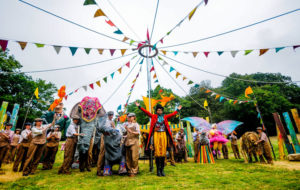
RWCMD Annual Puppetry Performance
You are a visual artist as well as a theatre designer. Do the skills required to work in these art forms relate to each other?
A lot of my making skills and language of creative expression came from my training as a Theatre Designer. At the start of my Master of Fine Art course at Cardiff School of Art and Design, I could make an installation art piece or a sculpture pretty much exactly as I had planned it. I was used to being resourceful, problem solving and making under pressure. However, this foxed my Fine Art lecturers quite a bit as my process was very different from a Fine Art process. I very quickly realised that I needed to begin to discover what my work was about at this point through a more unpredictable process, to use this opportunity to explore not planning for an end product. As a designer, I can be playful in my preparatory model boxes, drawing etc., but as an artist, I started to push myself to play through the entire process of making with no pre-defined end product. This created an interesting tension and challenged me in a whole different way. I am very grateful to have explored the distinction between these two roles as a creative practitioner at that point. I graduated feeling confident in how I work.
As an associate artist of accessible and inclusive theatre company, Taking Flight, you are often breaking new ground with regards to access relating to areas of design. Do you think this is fair to say?
As an associate artist of Taking Flight, my role is incredibly exciting as I have opportunities and support to push the boundaries of creative access within the realms of design for their productions year on year. It is a constantly evolving area of research and most of this is done through Research and Development periods and whilst engaged in preparatory work and rehearsals for the show.
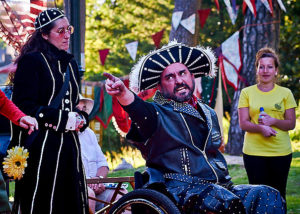
Increasingly, I have developed the sensory potential of the costumes, props and site dressing. These are rich in texture and detail which, whether an audience member or performer has a sensory disability or not, adds conceptual and experiential depth to the design. BSL interpreters and audio describers have roles in the production. I inform audio description from a design perspective and consider the sounds my costumes and props make in helping to define and identify a character. For Director, Elise Davison, and I, access is never an afterthought or an add-on, it is an integral part of the show. The creative potential is massive and enthralling – it enters my dreams at night!
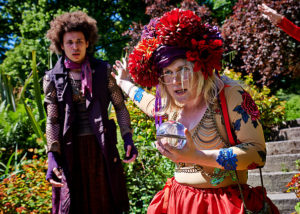
Taking Flight’s ‘Breaking Out of the Box’ symposiums bring theatre and access practitioners together to discuss the inherent challenges and creative developments. I cannot wait to explore creative captioning and audio description in ways informed by the works of Ramps on the Moon, Solar Bear and other interesting companies. I have been inspired to produce tactile pre-show boxes and models with advice from Robin Bray-Hurren from Graeae Theatre in addition to designing for touch tours. Being at the forefront of accessible and inclusive theatre, being part of a vital creative conversation, is a wonderful place to be making work.
And as if you aren’t already busy enough you are also a “current Senior Lecturer for the BA Creative and Therapeutic Arts, one of only two courses of its kind in the UK promoting the development of refined workshop facilitation techniques for inclusive and community benefiting creative interventions.” I wonder if you could tell us more about this role?
I was initially employed as a visiting lecturer, teaching art skills to students on the course. It was very different when I started in 2011, where students went out on placement, delivering art workshops only in education settings. I very quickly became Senior Lecturer and then Course Leader for 4 years and during this time, the course developed in a very exciting way. The placements and types of participants the students worked with opened up to incorporate elderly care homes, homeless charities, refugees and asylum seekers, women and children with experience of domestic abuse, people with disabilities of all ages, and the list keeps growing. This is to reflect the growing need for creative interventions, alternatives to the norm, to help participants grow, develop, connect with others and achieve a sense of wellbeing. The course incorporates placements every year, art studio practice as a prominent component, and supporting theoretical subjects such as Therapeutic Principles, Inclusive Practice, Human Development and many more. We feel that our students are very much at the forefront of this area of work, and they are supported by lecturers who are also engaged in current practice. I now enjoy lecturing on the course part-time, and my colleague Beth Pickard is Course Leader. Her vision continues to take the course from strength to strength.
Get the Chance works to support a diverse range of members of the public to access cultural provision Are you aware of any barriers to equality and diversity for either Welsh or Wales based artists or designers?
I am very fortunate that in my own work I am usually surrounded by theatre practitioners, artists and creatives in general who are exploring the potential of inclusive practice with great enthusiasm. The role of a set and costume designer naturally demands that you deliver something beautiful, engaging or striking within restricted and often short time frames, under pressure, within a budget and against the odds that come your way. It is therefore frustrating when access is not a part of the process from the beginning. It is difficult for a designer to ensure that the vision for the show is cohesively applied across the production if the access requirements are added on at the end. It should be a dramaturgical decision really. However, the reality is that this conversation regarding creative access is far from mainstream and is still a very new concept to some companies. Consequently, I feel it important to champion this in my work.
If you were able to fund an area of the arts in Wales what would this be and why?
I think the more research into creative access, the better. More funding will enable a rich exploration of potential methods and strategies to be adopted more universally.
What excites you about the arts in Wales?
The ability to regularly work bilingually in a prolific Welsh language arts scene.
What was the last really great thing that you experienced that you would like to share with our readers?
I went to see F.E.A.R. by Mr and Mrs Clark at Chapter Arts Centre. This was an intimate, one man performance that had me gripped the whole way through and anxious about everyday, life worries and getting older! It also had an accompanying film that operated as a collage of nostalgic footage and impending doom – signature Andrew James Rock!
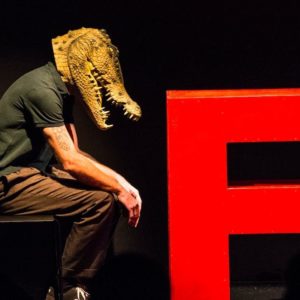
FEAR by Mrs & Mrs Clark
Thanks for your time Becky
